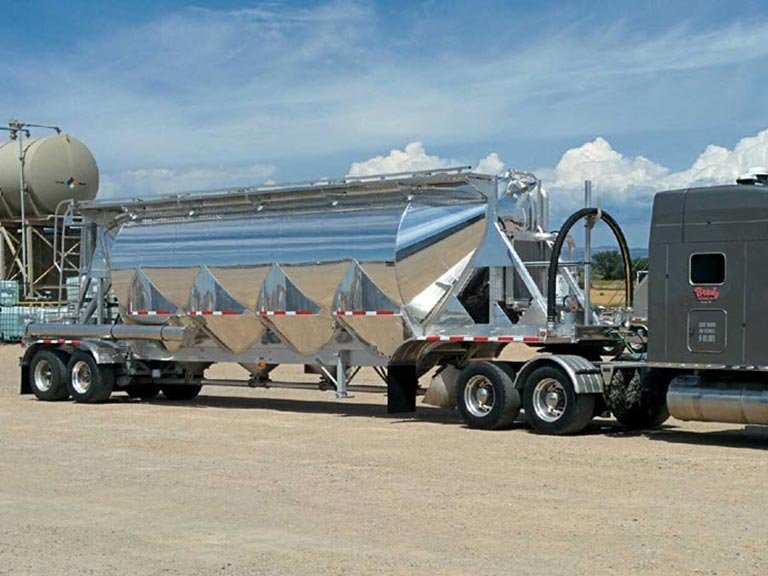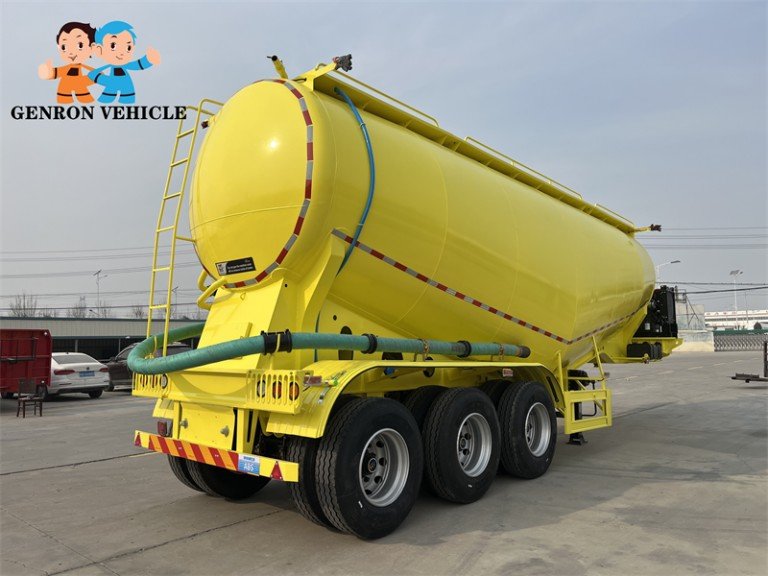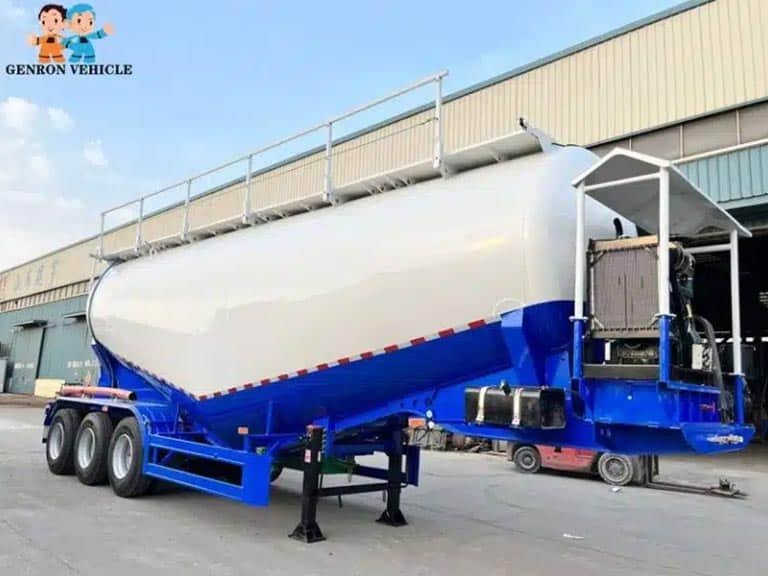Do you know the essential steps for loading a dry bulk tanker safely? This is crucial for transporting powdered or granular materials. Proper loading techniques are vital. They prevent material contamination, ensure weight distribution, and maintain safety standards.
Genron International Trade specializes in manufacturing tanker trailers with advanced features. Our dry bulk tanks, also known as cement bulkers or silo trailers, are designed for transporting materials like cement, fly ash, and plastic pellets.
In this guide, we’ll cover the key steps and best practices for operating dry bulk tankers efficiently.
Table of Contents
Understanding Dry Bulk Tankers
A dry bulk tanker is designed for transporting dry, flowable materials in bulk quantities without packaging. These tankers handle various materials, including cement, fly ash, and plastic pellets. They are essential in many industries.
Dry bulk tankers transport a wide range of materials. From dense powders like cement to lighter granular substances like plastic pellets. Their versatility makes them suitable for construction and manufacturing applications.
The key components of a dry bulk tanker include the tank body, manholes, pressure relief valves, discharge valves, and air compressor systems. These components work together for efficient loading and unloading. They ensure safe and reliable transportation of materials.
At Genron International Trade, we recognize the importance of dry bulk tankers in efficient material transport. As a leading semi-trailer manufacturer, we have a deep understanding of these specialized vehicles’ design and functionality.
Begin with a bespoke semi-trailer designed for your exact needs. Whether it’s heavy-duty hauling or specialized cargo, we’ve got the perfect solution to keep you moving forward.
Preparing to Load a Dry Bulk Tanker
Effective loading of a dry bulk tanker requires meticulous planning and preparation. At Genron International Trade, we stress the importance of thorough checks before loading. This ensures safety, efficiency, and material integrity.
Pre-Loading Inspection Checklist
Before loading, a comprehensive inspection is crucial. This includes checking the tanker’s structural integrity for cracks, loose bolts, or damage. People also inspect all valves, ensuring they operate smoothly without blockage or air leakage.
- Check and clear dust and slag from the tank and discharge pipe.
- Verify that all pipes and valves operate flexibly.
- Inspect the tank, frame, suspension, and key components for damage.
- Check the lighting and braking system for normal operation.
Essential Equipment for Loading
The right equipment is vital for safe and efficient loading. A functioning air compressor system is essential for both loading and unloading operations. People need to ensure all seals, gaskets, and connecting parts are in good condition to prevent material leakage or air pressure loss.
Setting Up the Loading Area
Proper setup of the loading area is critical. Position the tanker on level ground, stabilize it to prevent shifting, and ensure adequate clearance and appropriate connections for loading equipment. Safety measures, including personal protective equipment (PPE), are also put in place to protect against dust and potential hazards.
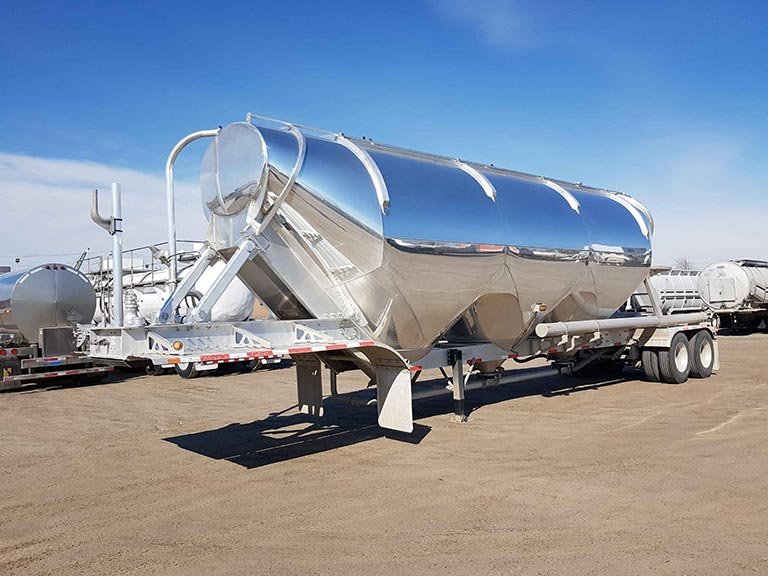
Step-by-Step Process to Load a Dry Bulk Tanker
To load a dry bulk tanker safely and efficiently, understanding the step-by-step process is crucial. At Genron International Trade, we emphasize following proper procedures for the safe transportation of bulk materials.
- Safety Gear and Precautions: Before starting the loading process, wearing appropriate personal protective equipment is essential. This includes respiratory protection, safety glasses, gloves, and high-visibility clothing. This gear protects against dust and other hazards associated with loading bulk materials.
- Opening the Manhole and Exhaust Valve: First, release any remaining pressure in the tank by opening the pressure relief and exhaust valves. This step is crucial for safety, preventing injuries. After the pressure is released, the manhole cover can be opened and secured. This prepares the tank for loading.
- Aligning the Loading Ports: Next, position the tanker correctly under the loading chute or attach the loading hose properly. Ensure the alignment is precise to avoid spills or dust release. For instance, when loading cement, aligning the material loading and unloading ports is essential.
- Monitoring the Loading Process: During loading, keep an eye on the pressure gauge to ensure safe operation. Dry bulk tankers have visible pressure gauges for easy monitoring. Also, watch the material level indicators or levelers in the tank. Stop loading immediately when the tank is full.
- Securing the Tank After Loading: After loading is finished, secure all manholes, valves, and loading ports. Clean any material buildup from sealing surfaces for airtight closures. Finally, inspect all closures, pressure readings, and securing mechanisms before leaving the loading area.

Maintenance and Troubleshooting
Regular maintenance is not just recommended; it’s essential for your dry bulk tanker’s longevity and efficiency. At Genron International Trade, we know how crucial it is to maintain your equipment. This prevents costly breakdowns and extends its lifespan.
- Post-Loading Cleaning Procedures: After loading, clean all valves, pipes, and discharge mechanisms to prevent material buildup. Focus on removing ash deposits and cement residue from the tank interior and exterior. These can cause corrosion and deterioration over time.
- Regular Maintenance Requirements: The air compressor system needs special attention. Replace compressor oil after 15 hours of initial use and every 120 hours thereafter. Use the specified diesel engine oil. Regularly check and tighten all bolts and connections, ensuring the correct torque.
- Common Loading Problems and Solutions: Common issues include pressure problems, valve blockages, and air leakage. Troubleshoot by checking valve functionality, inspecting seals, and verifying compressor operation. For air leakage, inspect all connection points, gaskets, and seals. Replace any damaged components immediately.
| Maintenance Task | Frequency | Importance |
| Compressor Oil Replacement | Every 120 hours | High |
| Valve Inspection | After each use | High |
| Tank Cleaning | After each load | High |
| Bolt and Connection Check | Every 2 weeks | Medium |
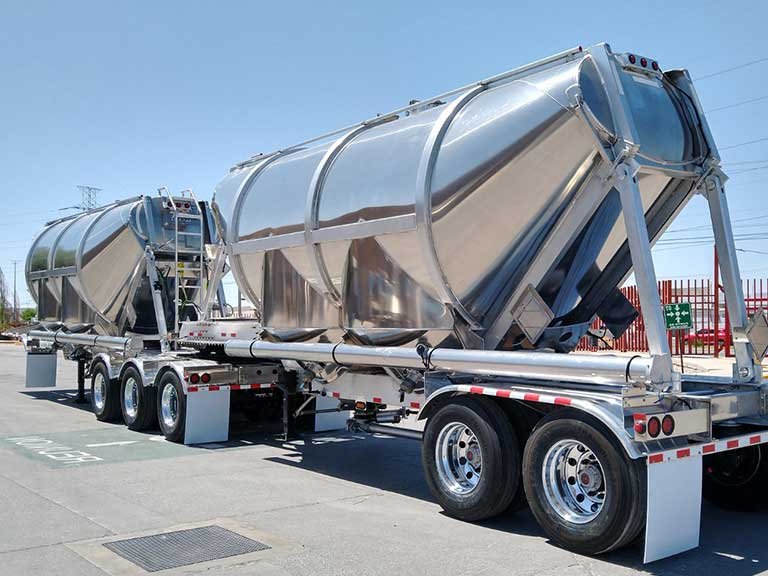
Conclusion
At Genron International Trade, we grasp the critical role of proper dry bulk tanker loading for safe and efficient transport. Our tankers boast advanced features for easier loading and unloading. These include optimized valve placement and reliable pressure monitoring systems. By adhering to the guidelines in this article, operators can ensure efficient loading processes while minimizing risks.
Regular maintenance, encompassing proper cleaning and compressor upkeep, is vital for maintaining your tanker’s optimal condition. Investing in quality equipment and adhering to proper operational procedures will extend your tanker’s lifespan.
FAQ
What safety precautions should be taken when unloading a cement tanker?
When unloading a cement tanker, people need to ensure the area is clear of personnel and wear appropriate safety gear. In addition, you also check the pressure gauge to avoid over-pressurization. Additionally, verifying that the exhaust valve is functioning correctly is crucial to prevent air leakage.
How often should the air compressor be maintained?
Regular maintenance of the air compressor, as per the manufacturer’s schedule, is recommended. This ensures optimal performance and prevents issues during operation.
What is the purpose of the manhole on a dry bulk tanker?
The manhole on a dry bulk tanker facilitates tank interior inspection and cleaning. People ensure it is securely closed before transporting materials to prevent dust leakage.
How do we prevent material accumulation during transport?
To prevent material accumulation, people ensure the tank is properly cleaned after each use. In addition, you also verify that the discharge system is functioning correctly. Regular maintenance of the tank and its components is essential.
What are the common issues with bulk cement tankers and how are they addressed?
Common issues include air leakage, clogged discharge systems, and pressure gauge malfunctions. We address these by performing regular maintenance, inspecting the tanker before and after use, and troubleshooting problems promptly.
Can an external air source be used with our bulk tanker trailer?
Yes, an external air source can be used with our bulk tanker trailer, provided it meets the specified pressure and connection requirements. We ensure compatibility and safe operation.
What is the rated working pressure for the bulk cement tanker?
The rated working pressure for our bulk cement tanker is specified in the product documentation. We adhere to this rating to ensure safe and efficient operation.

